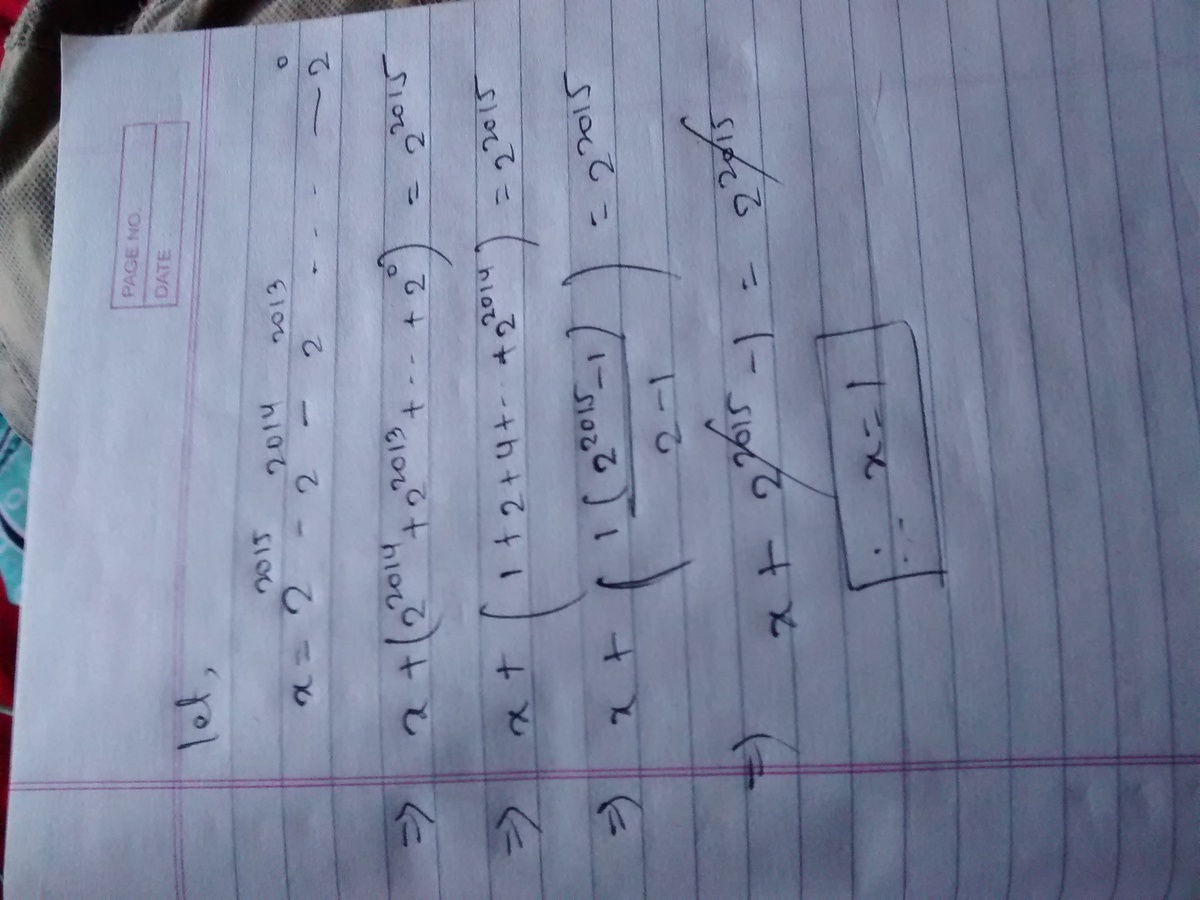Simply Simple
Find the value of 2 2 0 1 5 − 2 2 0 1 4 − 2 2 0 1 3 − 2 2 0 1 2 . . . . − 2 0
The answer is 1.
This section requires Javascript.
You are seeing this because something didn't load right. We suggest you, (a) try
refreshing the page, (b) enabling javascript if it is disabled on your browser and,
finally, (c)
loading the
non-javascript version of this page
. We're sorry about the hassle.
9 solutions
This is how I solved the question too, by using the fact that 2 n − 2 n − 1 = 2 n − 1
Thanks for explain it to the others!
You didn't have to do all that... you could have just used the identity 2^0+2^1+...+2^n = 2^(n+1)-1 That would have reduced a lot of effort.
Using 1 + x + x 2 + . . . + x n = x − 1 x n + 1 − 1 ... 2 2 0 1 5 − ( 2 2 0 1 4 + 2 2 0 1 3 + 2 2 0 1 2 + . . . + 1 ) = 2 2 0 1 5 − ( 2 2 0 1 5 − 1 ) = 1
Many people are taking the forward approach to this problem (as did I), but I have an alternate solution. We will claim the answer is 1 and prove this result.
Let 2 2 0 1 5 − 2 2 0 1 4 − 2 2 0 1 3 − … − 2 0 = 1 . Rearranging, we find that 1 + 2 0 + 2 1 + … + 2 2 0 1 3 + 2 2 0 1 4 = 2 2 0 1 5 . We will now inspect the left hand side.
The first two terms are 1 and 2 0 = 1 . Add these together to get 2 = 2 1 . The first two terms of our new expression are 2 1 and 2 1 . Since 2 k + 2 k = 2 × 2 k = 2 k + 1 , the first two terms of the newest sequence are 2 2 and 2 2 . We can repeat this over and over again until we reach 2 2 0 1 4 + 2 2 0 1 4 . Since 2 2 0 1 4 + 2 2 0 1 4 = 2 2 0 1 5 , the first term of our original sequence was in fact 1 .
If you're having trouble visualizing what I am describing, this may help.
2 2 0 1 5 2 2 0 1 5 = ( 1 + 2 0 ) + 2 1 + 2 2 + … + 2 2 0 1 4 = ( 2 1 + 2 1 ) + 2 2 + 2 3 + … + 2 2 0 1 4 = ( 2 2 + 2 2 ) + 2 3 + 2 4 + … + 2 2 0 1 4 = ⋮ = ( 2 2 0 1 3 + 2 2 0 1 3 ) + 2 2 0 1 4 = 2 2 0 1 4 + 2 2 0 1 4 = 2 2 0 1 5
The given expression =
2^2015 - [ 1+ 2 + 2^2 + 2^3 + ...... + 2^2014] =
2^2015 - [ sum of terms of a geometric sequence of common ratio 2 and number
of terms 2015] =
2^2015 - (2^2015 - 1)/(2 - 1) = 1
Let the sum be S, multiply both sides by 2 and then subtract 1st series from the 2nd to get 2S -S = 2^2016 - 2^2015 - 2^2015 + 2^0 = 2^0 = 1
Python:
1 2 3 4 5 6 |
|
Use this formula 2^n - 2^n-1 = 2^n-1.
Notice that 2^2015 = 2^2016 - 2^2015 2^2014 = 2^2015-2^2014 2^0 = 2^1 - 2^0 So 2^2015 - 2^2014 -...-2^0 = (2^2016-2^2015) - (2^2015-2^2014)-(2^2014-2^2013) - (2^2 - 2^1 ) - (2^1 - 2^0) = 2^2016 - 2^2015 - 2^2015 + 2^0 As 2• 2^2015 = 2^2016 the answer is 2^0 = 1

Observe a pattern -
{ 2 }^{ 5 }-{ 2 }^{ 4 }=16={ 2 }^{ 4 }
and
{ 2 }^{ 3 }-{ 2 }^{ 2 }={ 2 }^{ 2 }
So for any
{ 2 }^{ n }-{ 2 }^{ n-1 }={ 2 }^{ n-1 }
Or you can think about it in this way -
2^{ 5 }-{ 2 }^{ 4 }=2\times { 2 }^{ 4 }-2^{ 4 }\\ { 2 }^{ 4 }(2-1)={ 2 }^{ 4 }
Therefore, if you simplify the above pattern, you can observe the same pattern -
2 2 0 1 5 − 2 2 0 1 4 = 2 2 0 1 4 2 2 0 1 4 − 2 2 0 1 3 = 2 2 0 1 3 . . .
And this can be reduced to
2 2 − 2 1 = 2 1 2 1 − 2 0 = 2 − 1 = 1